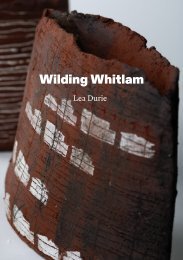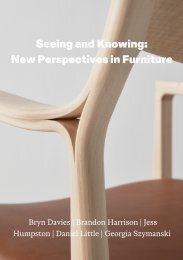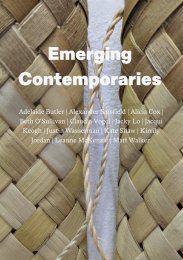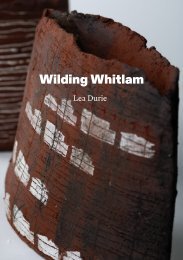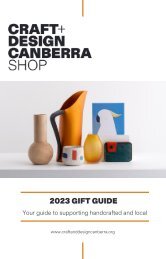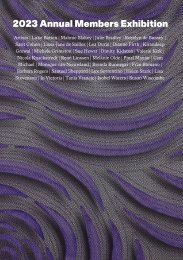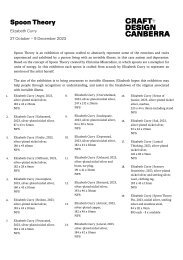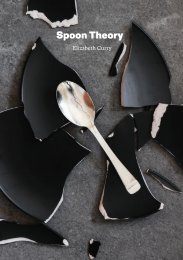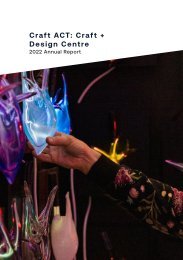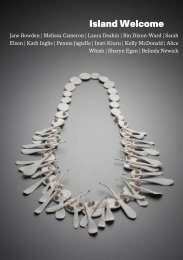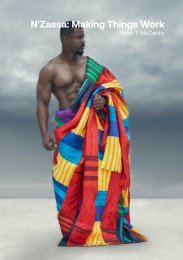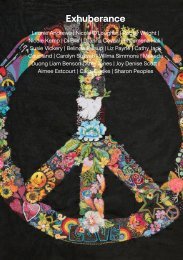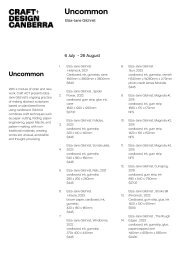Emerging Contemporaries
Emerging Contemporaries 4 February - 20 March 2021 Akka Ballenger | Mika Benesh | Millie Black | Maitlan Brown | Ned Collins | Lea Durie | Annalise Fredericks | Daniel Leone | Christine Little | David Liu | Denni Maroudas | Olinda Narayanan | Bling Yiu | Jonathon Zalakos Emerging Contemporaries is the Craft ACT National Award Exhibition for early-career artists. This exhibition plays a pivotal role in supporting and transitioning artists into professional practice and placing Australian artists in view of the national cultural collecting institutions, business and industry, and audience. We're always looking for new talent to nurture and add to our Craft ACT community. We have an Emerging Contemporaries Award that we give to emerging talent from a number of sources: Sturt School for Wood, Canberra Potters Society, Canberra Institute of Technology, University of Canberra, the ANU School of Art + Design, University of New South Wales and the CAPO Craft ACT Emerging Artist award.
Emerging Contemporaries
4 February - 20 March 2021
Akka Ballenger | Mika Benesh | Millie Black | Maitlan Brown | Ned Collins | Lea Durie | Annalise Fredericks | Daniel Leone | Christine Little | David Liu | Denni Maroudas | Olinda Narayanan | Bling Yiu | Jonathon Zalakos
Emerging Contemporaries is the Craft ACT National Award Exhibition for early-career artists. This exhibition plays a pivotal role in supporting and transitioning artists into professional practice and placing Australian artists in view of the national cultural collecting institutions, business and industry, and audience.
We're always looking for new talent to nurture and add to our Craft ACT community. We have an Emerging Contemporaries Award that we give to emerging talent from a number of sources: Sturt School for Wood, Canberra Potters Society, Canberra Institute of Technology, University of Canberra, the ANU School of Art + Design, University of New South Wales and the CAPO Craft ACT Emerging Artist award.
You also want an ePaper? Increase the reach of your titles
YUMPU automatically turns print PDFs into web optimized ePapers that Google loves.
EMERGING<br />
CONTEMPORARIES<br />
Craft ACT Craft + Design Centre
Craft ACT: Craft + Design Centre is supported by the ACT<br />
Government, the Visual Arts and Craft Strategy – an initiative<br />
of the Australian State and Territory Governments, and the<br />
Australia Council for the Arts – the Australian Government’s arts<br />
funding and advisory body.<br />
CRAFT ACT CRAFT + DESIGN CENTRE<br />
Tues–Fri 10am–5pm<br />
Saturdays 12–4pm<br />
Level 1, North Building, 180 London Circuit,<br />
Canberra ACT Australia<br />
+61 2 6262 9333<br />
www.craftact.org.au<br />
Cover image: Denni Maroudas, Articular chaise, 2020, American<br />
ash, walnut. Photo: Courtesy of the artist.<br />
Page 4-5: <strong>Emerging</strong> <strong>Contemporaries</strong>, installation view. Photo: 5<br />
Foot Photography.
EMERGING<br />
CONTEMPORARIES<br />
AKKA BALLENGER | MIKA BENESH | MILLIE BLACK | MAITLAN BROWN | NED<br />
COLLINS | LEA DURIE | ANNALISE FREDERICKS | DANIEL LEONE | CHRISTINE<br />
LITTLE | DAVID LIU | DENNI MAROUDAS | OLINDA NARAYANAN | BLING YIU |<br />
JONATHON ZALAKOS<br />
Craft ACT Craft + Design Centre<br />
4 FEBRUARY - 20 MARCH 2021<br />
3
4
5
<strong>Emerging</strong> <strong>Contemporaries</strong><br />
Exhibition statement<br />
<strong>Emerging</strong> <strong>Contemporaries</strong> is the Craft ACT<br />
National Award Exhibition for early-career<br />
artists. This exhibition plays a pivotal role<br />
in supporting and transitioning artists<br />
into professional practice and placing<br />
Australian artists in view of the national<br />
cultural collecting institutions, business<br />
and industry, and audience.<br />
We’re always looking for new talent<br />
to nurture and add to our Craft ACT<br />
community. We have an <strong>Emerging</strong><br />
<strong>Contemporaries</strong> Award that we give to<br />
emerging talent from a number of sources:<br />
Sturt School for Wood, Canberra Potters<br />
Society, Canberra Institute of Technology,<br />
University of Canberra, the ANU School<br />
of Art + Design, University of New South<br />
Wales and the CAPO Craft ACT <strong>Emerging</strong><br />
Artist award.<br />
Image: Ned Collins, A Statement on Cabinets and<br />
the Curiosities of Containment (detail), 2020, walnut<br />
casework and rock maple. Photo: courtesy of the artist.<br />
7
8
Exhibition essay<br />
Catalogue essay: Dr Sarah Schmidt<br />
Today there is a great wealth of artists,<br />
craft and design people practicing in<br />
Canberra, which is itself, a designed city.<br />
The diversity of practice encompasses<br />
many disciplines, bringing additional<br />
interest, innovation and vitality, to the<br />
national capital: from furniture making<br />
and ceramics, to sculpture, and digital<br />
art, to glass art, gold and silversmithing,<br />
metalwork, painting, work on paper, and<br />
textiles. This is an active community of<br />
artists, craft and design people. From<br />
the work of individual artists, to groups<br />
engaged in collaborative making, we<br />
are fortunate to enjoy such creativity<br />
and outstanding practice in our art and<br />
design community.<br />
Another feature of the diversity of<br />
practice across Canberra is the embrace<br />
of very established practitioners,<br />
as shown in ‘Intersection’, being<br />
celebrated alongside emerging artists<br />
that exhibitions such as ‘<strong>Emerging</strong><br />
<strong>Contemporaries</strong>’ support.<br />
I would like to pay attention and respect<br />
to the work of each of these emerging<br />
artists with these short statements of<br />
response:<br />
Mika Benesh: ‘Weaving Futures’<br />
encompasses responses to a number of<br />
ritual Jewish objects, responses which<br />
carry conceptual concerns as well as<br />
those of craft and design. The ritual<br />
mug shows a creative ingenuity both in<br />
design and process. It is crafted from<br />
woven candle wicks, dipped in molten<br />
beeswax, cast in bronze, and then silverplated.<br />
The finished object, for ritual use,<br />
is functional yet full of mystery.<br />
Millie Black: This artist’s explorations of<br />
air and ground, her creative responses<br />
made in thread and paper, make a<br />
strong environmental statement about<br />
a reverence for landscape. As both a<br />
painter and textile artist with a feeling<br />
for sculpture, Millie develops very<br />
sensitive works showing an affinity with<br />
nature. Bushwalking, and making with<br />
natural dyes and pigments, are central to<br />
her process.<br />
Image: Bling Yiu, Be fruitful and multiply, 2021, handbuilding,<br />
mid-fire. Photo: Courtesy of the artist.<br />
9
Maitlan Brown: As a young and<br />
productive industrial designer Maitlan<br />
explores and experiments with organic<br />
forms, new technologies and processes<br />
to access functional and aesthetic<br />
solutions.<br />
Her final chair prototype shows both<br />
creative flair and sensitive design and<br />
reflects her genuine excitement in the<br />
possibilities and newness of 3D printing<br />
technologies.<br />
Akka Ballinger Constanin: Akka<br />
communicates an ecological awareness<br />
in her drawing and printmaking,<br />
sometimes using leaves to paint on<br />
to emphasize this foundation in her<br />
practice .Her excellent video gives a<br />
summary of her work and process, her<br />
awareness of environment and the need<br />
for education and action.<br />
Ned Collins: Through exploration and<br />
questioning, and applying a curious and<br />
contemporary mindset, together with<br />
fine cabinetry techniques and skills, Ned<br />
has created a functional and fluid form<br />
in ‘A Statement on Cabinets and the<br />
Curiosities of Containment’ (2020). It is<br />
a design to be played with. It achieves<br />
as an interactive work of art. And it is<br />
beautiful.<br />
Lea Durie: Lea combines her studies<br />
in Landscape Architecture, Ceramics<br />
and Visual Arts to inform her work<br />
and her responses to drought in the<br />
Murray Darling system; ‘When the Rivers<br />
Run Dry’ originates from the artist’s<br />
shock experienced in encountering<br />
dry waterways on a road trip to Broken<br />
Hill. The work leaves us pondering and<br />
so delivers the thoughtful ecological<br />
message it intends to.<br />
Annalise Frediwicks: Using her wit and<br />
the convention of the trope this artist<br />
brings an incisive vision to the knitwear<br />
catalogue, featuring items such as a<br />
knitted aluminum mask.<br />
Daniel Leone: David’s ceramic sculpture<br />
with its primitive-modernist feel<br />
encourages us to rethink a simple<br />
human stance, with a simplicity of being,<br />
and of form. The work encourages us to<br />
see the human form in a new way.<br />
10
David Liu: David’s leaf table, abstracted<br />
from the shapes of a curly leaf, is<br />
marvelously dynamic with its angular<br />
spatial construction that gives the table<br />
a highly sculptural form. Its smooth<br />
finish and attractive grain are quite<br />
seductive.<br />
Denni Maroudas: Denni’s work concerns<br />
the qualities of form, function, shape,<br />
and material. The ‘Sinuous Bench’<br />
contrasts so greatly with the static<br />
shape of the ‘Rest Wall Hung Cabinet.’<br />
This contrast is interesting and shows<br />
a terrific versatility, arising from the<br />
artist’s interest in carving, altering, and<br />
shaping.<br />
Olinda Narayanan: Horizontal soft<br />
indigo thread is woven between vertical<br />
poles to create spatial connections,<br />
reflective of interpersonal relationships.<br />
Narayanan carefully builds an<br />
interesting series of spaces which<br />
draw the viewer not only into but also<br />
through, semitransparent screens; it is<br />
an entrancing statement reflective of<br />
aspects of mind and imagination that<br />
this artist creates.<br />
Christine Little: This artist is interested<br />
in the places we inhabit. Her exploration<br />
of place also explores process. Here she<br />
has used photography to establish the<br />
tonal values that are key to this striking<br />
work.<br />
Bling Yiu: Speckled ceramic forms are<br />
taken to another realm with optimistic<br />
and inspired human attributes; possibly<br />
influenced or linking with her earlier work<br />
as a children’s book illustrator. Other<br />
pieces decorated in blue have echoes<br />
of centuries old ceramics, applied in a<br />
modern form.<br />
Jonathan Zalakos: As a jeweler and<br />
object maker, Jonathan explores<br />
the complexities of the mind -body<br />
dilemma with a variety of materials<br />
and interactions, such as plastics and<br />
metals, which combine to give both form<br />
and linear characteristics. His work is<br />
creative, explorative and original and<br />
succeeds at multiple levels.<br />
We all have a role to play in this<br />
creative community, of balancing the<br />
fostering and development of emerging<br />
practitioners, as well as celebrating<br />
11
the extraordinary achievements of<br />
those artists and craftspeople already<br />
enjoying success, or who have a careerlong<br />
journey that is ripe for the survey<br />
exhibition.<br />
Different skills and aptitudes are involved<br />
in curating the work of artists who<br />
audiences know well, versus building<br />
emerging practitioners, stimulating their<br />
practice, and engendering opportunities,<br />
and new networks for them. Good<br />
curatorial work responds to both: it<br />
caters for all aspects of this creative<br />
field, seeing how each vital community,<br />
of emerging artists, mid-career artists<br />
and established practitioners, all interrelate.<br />
Moreover, the best curatorial<br />
practice is a creative act itself: stepping<br />
forward with a confident eye, and armed<br />
also with a knowledge of theory and art<br />
history —and other forms of acquired<br />
knowledge— and putting this into<br />
practice with artistic judgement and<br />
analysis, to make brave new choices,<br />
curating new names, new artists,<br />
that bring new voices and images to<br />
audiences, rather than solely reinforcing<br />
the pedigrees of celebrated art heroes.<br />
Both the art heroes and the newcomers<br />
are important, but I offer a provocation<br />
to curators to be clever and creative in<br />
12<br />
discovering new work; and I hope this<br />
statement will also offer inspiration<br />
to those ‘<strong>Emerging</strong> <strong>Contemporaries</strong>’<br />
exhibiting here at Craft ACT; knowing<br />
that curators and institutions do look<br />
and observe, and new opportunities and<br />
partnerships are always forming and<br />
evolving.<br />
The Craft ACT 2021 program launches<br />
strongly, catering to the different<br />
streams of both emerging artists and<br />
established practitioners, as evidenced<br />
so well, with these two exhibitions<br />
that mark the commencement of the<br />
2021 program. There is a very worthy<br />
commitment here, to encouraging and<br />
sustaining creative people and emerging<br />
artists, and profiling the work of some<br />
of Canberra’s most established artists<br />
and craftspeople. I congratulate each of<br />
the artists, designers and craftspeople<br />
involved, together with Craft ACT CEO<br />
Rachael Coghlan and her team.<br />
Dr Sarah Schmidt, Director<br />
Canberra Museum and Gallery | The<br />
Nolan Collection<br />
Image left: Olinda Narayanan, Drifting in one place<br />
(detail), 2020, indigo dyed thread, copper and wooden<br />
supports. Photo: Courtesy of the artist.<br />
Page 14-15: <strong>Emerging</strong> <strong>Contemporaries</strong>, installation view.<br />
Photo: 5 Foot Photography
13
14
15
Akka Ballenger Constantin<br />
Canberra Institute of Technology<br />
Artist statement<br />
“The Lost Ark” is an opportunity of<br />
learning together. This series of drawings,<br />
linocuts and etchings brings back the<br />
focus on the aftermath of the 2019-2020<br />
bush fires and their impact on our unique<br />
Australian fauna.<br />
An interim report, “Australia’s 2019-2020<br />
Bushfires: The Wildlife Toll” commissioned<br />
by WWF Australia concluded that more<br />
than three billion animals were killed or<br />
displaced: 143 million mammals, 2.46<br />
billion reptiles, 180 million birds and 51<br />
million frogs.<br />
I am an art educator, working with young<br />
children. Often, I find myself embracing<br />
their spontaneity in my own artistic<br />
practice and for this body of works I<br />
chose the same informal approach, where<br />
feeling and playfulness prevail, taking over<br />
realistic/ natural illustration detail.<br />
Biography<br />
Romanian-born Akka Ballenger Constantin<br />
has swapped the beloved mountains<br />
of her homeland for the Canberran<br />
grasslands. An almost perfect trade –<br />
although occasionally, she misses the<br />
heights. She explores her surroundings<br />
through keen observation, often focusing<br />
on the unseen detail, rather than on the<br />
obvious scenery.<br />
A multi-disciplinary artist working across<br />
various platforms, she loves mixing new<br />
and old, traditional and contemporary,<br />
digital and analogue. Her practice<br />
combines over 20 years’ experience in<br />
photography and alternate processes,<br />
with other (newly-found) mediums such<br />
as drawing, mixed media, printmaking and<br />
spoken words.<br />
Through these images, I hope to bring<br />
into the limelight some of our unique<br />
species and I would like to encourage the<br />
public not only to learn more about our<br />
wildlife, but also to donate their time and<br />
to support financially the Wildlife rescue<br />
programs.”<br />
Image: The Lost Ark, 2020, paint, canvas, wooden frame,<br />
dimensions variable. Photo: Courtesy of the artist.<br />
17
Mika Benesh<br />
University of New South Wales<br />
Artist statement<br />
Weaving Futures is an ongoing series of<br />
Jewish ritual objects designed to facilitate<br />
emerging and marginal Jewish ritual<br />
practices, particularly those which are<br />
queer, feminist and anti-colonial in nature.<br />
At the first stage of the fabrication<br />
process, the hannukiah, spice box, and<br />
natla (hand washing cup) are crafted<br />
out of woven candle wicks and dipped in<br />
molten beeswax. As pictured, in the final<br />
fabrication stages the pieces are cast in<br />
bronze and then silver-plated.<br />
The objects crafted in Weaving Futures<br />
can be used in a variety of different ways,<br />
with the project exploring the potential for<br />
non-prescriptivist design to catch a small<br />
hold of many Jewish futures.<br />
Biography<br />
Mika Benesh is an artist / writer / designer<br />
working on unceded Gadigal land in<br />
Sydney, Australia.<br />
Their practice traces relationships<br />
between cultural institutions, spirituality<br />
& theology, archives, queer/trans lives &<br />
movements, and white supremacy.<br />
Mika’s interested in facilitating emerging<br />
& marginal Jewish ritual practices through<br />
Judaica design.<br />
He works in jewellery and object design,<br />
graphite, print and book making,<br />
photography, and textiles.<br />
Image: Weaving Futures, 2020-2021, satin print, 42.0 x<br />
59.4cm. Photo: Courtesy of the artist.<br />
19
Millie Black<br />
ANU School of Art + Design<br />
Artist statement<br />
Grounding Atmospheres tracks the<br />
conscious and subconscious marks<br />
of the human in nature. In my practice,<br />
I explore the dualisms that detach the<br />
human from nature brought about by the<br />
cultural construct of the ‘Wilderness’ ideal.<br />
To dissolve this figure-ground separation<br />
that has outlined the tradition of Western<br />
landscape painting, I explore the<br />
purpose of ground and air in connecting<br />
ourselves to the environment by using<br />
earth pigments and plant dyes from<br />
the landscape I work with. Grounding<br />
Atmospheres removes an anthropocentric<br />
view of the land and explores the deep<br />
layers of the air and the ground by bringing<br />
an awareness to our breathing and<br />
dependence on nature. This is presented<br />
through the unwoven negative space<br />
and the supple nature of the cloth and<br />
fibres. In this, I hope to promote a greater<br />
awareness of the air and the importance<br />
of seeing ourselves as part of nature.<br />
Biography<br />
Millie Black is a painter and textile artist<br />
currently living and working on Ngunnawal<br />
Country. Her working process involves<br />
bush walking and painting in oil and<br />
watercolour with organic pigments from<br />
the environment she is in. More recently<br />
Black has incorporated weaving into<br />
her painting practice, experimenting<br />
with painted paper that she spins into<br />
thread prior to weaving. Black’s work<br />
aims to provide a connection to the<br />
natural environment and make aware our<br />
dependence on and roll in it. Her current<br />
practice-led research explores the breath<br />
as this connection and the importance<br />
of the air in weaving together human and<br />
nature.<br />
Image: Of Solitude (detail), 2021, watercolour on wool<br />
warp, 25 x 37 cm. Photo: Courtesy of the artist.<br />
21
Maitlan Brown<br />
University of Canberra<br />
Artist statement<br />
The Articular chaise is the result of<br />
an exploration into the possibilities of<br />
sustainable, large-scale 3d Printing.<br />
The work is produced by leveraging 6-axis<br />
industrial robot arm fitted with prototype<br />
plastic extruder developed in-house at the<br />
University of Canberra.<br />
The development of a sustainable outdoor<br />
seating concept presents a unique and<br />
organic form language. The form is<br />
in-part driven by the constraints of this<br />
new printing methodology. This printing<br />
method enables the sculptural form to not<br />
be possible through other processes of<br />
manufacturing.<br />
Biography<br />
Maitlan is an Industrial design<br />
undergraduate student from the University<br />
of Canberra. Her work centres upon<br />
exploring the intersection between<br />
traditional modes of making, and<br />
emergent manufacturing processes. Her<br />
current work focuses on the possibilities<br />
of large scale additive manufacturing<br />
and its implications for new sustainable<br />
product typologies in both form,<br />
composition and function.<br />
The possibilities of this new printing<br />
methodology encourages the use of<br />
shredded recycled plastic which can<br />
explore and address the contemporary<br />
global issue of plastic waste.<br />
Image: Articular chaise, 2020, 3D printed, dimensions<br />
variable. Photo: Courtesy of the artist.<br />
23
Ned Collins<br />
Sturt School for Wood<br />
Artist statement<br />
What is, what was, what will be<br />
hands deep within the soil, a small child<br />
plays.<br />
those building blocks that teach us are<br />
naive,<br />
yet they are old and wise<br />
we get older and find new building blocks<br />
to play with<br />
but those that are old have never lost their<br />
wisdom,<br />
have never stopped teaching us<br />
I have always had a deep reverence for<br />
craft. It is something old, something wise,<br />
somethin true to utility and true to beauty.<br />
It is this such involvement in the crafts, in<br />
the making of furniture, that finally gives<br />
voice, shape and direction to my artistic<br />
expressions. A world that nourishes my<br />
body with honest labour, my mind with<br />
puzzles and problems, and my soul with<br />
a way to let free those creations that exist<br />
within me.<br />
Biography<br />
Ned Collins is a recent graduate of Sturt<br />
School for Wood. His studies there<br />
allowed an exploration of self, of form,<br />
and of the traditional methods used in<br />
creating furniture. This was achieved by<br />
a relentless questioning of why, and by<br />
drawing inspiration from many artistic<br />
mediums outside of furniture. Collins<br />
seeks to further his practice by exploring<br />
the intersection between traditional<br />
methods and modern design to achieve<br />
functional, enduring creations.<br />
Image: A Statement on Cabinets and the Curiosities of<br />
Containment, 2020. Photo: Courtesy of the artist.<br />
25
Lea Durie<br />
Canberra Potters Society<br />
Artist statement<br />
When the River Runs Dry is a response to<br />
road trip to Broken Hill in 2019, through<br />
drought ravaged country, crossing once<br />
mighty rivers now pools of muddy water,<br />
along highways lined by cotton caught<br />
in the weeds by the roadside. It takes its<br />
name from community-based activism in<br />
Wilcannia in 2016 which sought to bring<br />
attention to the poor state of the Barka<br />
(Darling River) caused by both drought<br />
and water usage for large scale agriculture<br />
such as cotton farming.<br />
The work is an intersection of materials<br />
connected to this western NSW<br />
landscape. It has a quietness and detail<br />
that creates a space inviting the viewer<br />
to pause and ponder what has become<br />
of our Murray-Darling river system in this<br />
time of climate change. It questions the<br />
way that land is occupied and used in<br />
colonial and contemporary times.<br />
Biography<br />
Lea Durie is an artist based in Braidwood<br />
and Canberra. Lea is currently undertaking<br />
a Bachelor of Visual Arts with a ceramics<br />
major at the Australian National University<br />
School of Art and Design. Lea’s work<br />
explores post-colonial land use, its<br />
contribution to land degradation and<br />
climate change, and is influenced by<br />
feminist thinking and perspectives of<br />
place. Lea’s background as a landscape<br />
architect informs the mark making and<br />
conceptual thinking in her work.<br />
Lea’s work is often installation based,<br />
using ceramics as the foundation<br />
supported by found objects, textiles and<br />
other materials.<br />
Lea was the recipient Craft ACT 2020<br />
<strong>Emerging</strong> Artist’s award at the Canberra<br />
Potter’s Members Exhibition and was also<br />
the recipient of the ANU Boronia Award for<br />
academic excellence in ceramics in 2018.<br />
Image: When the River Runs Dry, 2020, ceramic,<br />
cotton thread and cloth, beeswax, timber and metal,<br />
dimensions variable. Photo: Lean Timms.<br />
27
Annalise Fredericks<br />
ANU School of Art + Design<br />
Artist statement<br />
Presented as a vintage knitwear<br />
catalogue, Maille Order combines our<br />
current need for personal protection and<br />
how we might consider what we wear as<br />
armour, with kitsch styling. The ‘knitting’<br />
of armoured face masks, an apron and<br />
jumper, conflates women’s work and the<br />
masculine associations of chain maille.<br />
Asking questions about how function and<br />
value can be subverted through material<br />
associations and tongue-in-cheek tropes.<br />
The viewer is invited to leaf through this<br />
fashion pamphlet and to indulge in the<br />
product’s absurd futility.<br />
Biography<br />
Annalise Fredericks is a multimedia visual<br />
artist and aspiring costume and concept<br />
designer.<br />
Having graduated from the ANU School of<br />
Art and Design with a Bachelor of Visual<br />
Arts, Annalise works across a variety of<br />
different mediums, ranging from painting<br />
and printmaking, to sculpture and textile<br />
work. Her work tends towards exploring<br />
and experimenting with materiality<br />
and texture, often leaning towards<br />
themes of fantasy, stories, history, and<br />
the surreal. A key aim with her work is<br />
pushing the limitations of and subverting<br />
the expectations of the viewer through<br />
materials.<br />
Image: Chain Link Jumper, 2020, aluminium, 1.6 x 10mm<br />
rings. Photo: Annalise Fredericks<br />
29
Daniel Leone<br />
CAPO Craft ACT <strong>Emerging</strong> Artist award<br />
Artist Statement<br />
At 16 years old, 11 years ago, I bought<br />
a teeshirt from a local Canberra based<br />
artist Luke Chiswell from which this<br />
sculpture is inspired from. Luke has been<br />
a massive inspiration for myself, not<br />
just aesthetically but also practice and<br />
career wise. The sculpture came about<br />
as a means to display the original teeshirt<br />
whilst mirroring and playing with the logo.<br />
Scale plays an important role in this piece<br />
giving it presence as we might another<br />
human. I find it fun to imagine such a<br />
creature walking around. The message<br />
is simple and deserves to be set in stone<br />
(rather stoneware). Keep your head up.<br />
Biography<br />
Daniel Leone is a multidisciplinary<br />
emerging artist from the Canberra region.<br />
Daniel’s ceramic work is handbuilt, using<br />
a system of concentric coils which are<br />
pinched into the desired form. Daniel<br />
graduated from Sturt School for Wood in<br />
2019 and continues to work in a variety<br />
of media, creating a range of functional,<br />
abstract and wearable objects.<br />
Image: Still holding my head up, after Chiswell, 2020,<br />
terracotta and steel framing. Photo: Craft ACT<br />
31
Christine Little<br />
Canberra Institute of Technology<br />
Artist statement<br />
I work in painting, drawing and<br />
printmaking using landscapes, both<br />
natural and urban, to explore the physical<br />
spaces we inhabit, isolation and human<br />
connection to the environment and lack<br />
thereof. I explore the interaction and<br />
contrast between natural and man-made<br />
landscapes.<br />
As a starting point for this work, I<br />
took photographs of a local shopping<br />
centre and of a sports ground. I have<br />
reinterpreted these suburban spaces with<br />
abstraction and with the use of light and<br />
dark tones.<br />
Biography<br />
I’m interested in painting, drawing and<br />
printmaking. My subject matter tends to<br />
be landscapes both natural and urban. My<br />
work is small scale, A3 or smaller.<br />
I explore the contrast between natural<br />
and man-made landscapes, there<br />
interconnection and disconnection. My<br />
landscapes are without people making a<br />
statement about isolation.<br />
I’m currently working on drawings and<br />
intaglio prints based on local suburban<br />
landscapes and buildings in an abstracted<br />
manner.<br />
Currently I am studying Visual Arts at CIT,<br />
Reid Canberra.<br />
Image: Contrasting Constructions, intaglio prints and<br />
drawings with graphite and colour pencils, acrylic paint<br />
pen on Stonehenge paper, 23 x 28.5 cm each. Photo:<br />
Courtesy of the artst.<br />
33
David Liu<br />
ANU School of Art + Design<br />
Artist statement<br />
I never thought I would like making<br />
wooden furniture. But from the moment<br />
I touched the fresh timber out of the<br />
thicknesser, I realised that it is the thing<br />
I endeavour for the rest of my life. I love<br />
traditional tools and using them to make<br />
hand-crafted joineries. It helped me to<br />
understand the timber better. My practice<br />
focuses on the geometric forms and<br />
perspective view of the object, which I<br />
hope to invite people to contemplate my<br />
works and rethink it from a distinct angle.<br />
Biography<br />
David is a Cabrera-based artist, designer<br />
and furniture maker. He uses geometric<br />
shapes and perspective views in his<br />
furniture practice and highlights his<br />
work with optical illusion. Audiences are<br />
invited to look at and interpret his works<br />
from different angles. David understands<br />
and expresses the beauty of a complex<br />
world with simplified forms. For instance,<br />
he abstracted the shapes of a curly<br />
leaf and designed the Leaf Table. David<br />
holds a Bachelor of Design degree from<br />
ANU School of Art and Design, is the<br />
2021 furniture workshop associate in<br />
JamFactory, Adelaide.<br />
Image: Leaf Table (detail), 2018, walnut, 30 x 150 x 40cm.<br />
Photo: Prue Hazelgrove.<br />
35
Denni Maroudas<br />
Sturt School for Wood<br />
Artist statement<br />
I have always had a deep fascination with<br />
art, shape, form, the way things are made<br />
and the reason why.<br />
There is a burning desire in me to make<br />
and design. Creating objects - functional<br />
or not - brings me a great sense of<br />
purpose and fulfilment, that nothing else<br />
compares to.<br />
I can’t wait to continue creating for the rest<br />
of my life.<br />
Biography<br />
Denni Maroudas graduated from Sturt<br />
School for Wood in 2020, where he<br />
was awarded the Studio Woodworkers<br />
Australia Award. During which he took a<br />
particular interest in sculptural work. The<br />
limitless curves and intersecting lines<br />
made my brain wonder with creativity.<br />
Denni spent some time on the ‘artier’ side<br />
of woodworking, carving and shaping<br />
abstract pieces. he found himself heavily<br />
inspired by an Irish designer/maker<br />
named Joseph Walsh, who creates<br />
amazing abstract sculptures and pieces of<br />
furniture.<br />
Currently working out of Mittagong<br />
at Sturt School for Wood’s resident<br />
workshop has allowed Denni to play freely.<br />
At Sturt he discovered his love for all<br />
materials, not just wood. In the future, he<br />
hopes to work with many more mediums<br />
to create art in his own way. Denni has a<br />
real love for hand shaping, experiencing<br />
the satisfying ‘swoosh’ under his fingers<br />
while he is using a tool feels like home.<br />
Image: Twist Stool, 2020. Photo: Courtesy of the artist.<br />
37
Olinda Narayanan<br />
ANU School of Art + Design<br />
Artist statement<br />
Drifting In One Place explores boundary<br />
making through weaving. The mutual<br />
dependency of soft indigo dyed thread<br />
and structural supports creates an<br />
architectural tension. Which ultimately<br />
seeks to create new opportunities for<br />
people to interact with each other and<br />
with the built environment. This tension<br />
can be engaged with at a human scale,<br />
encouraging reflection on the coexisting<br />
boundaries and connections both in our<br />
interpersonal relationships and in space.<br />
This piece is part of an ongoing body of<br />
work exploring relationships, scale and<br />
surroundings called “Spatial Connections”.<br />
Biography<br />
Olinda is an emerging artist working<br />
with furniture, textiles and sculptural<br />
installation. She employs a combination of<br />
traditional hand making skills and digital<br />
technologies. Her art practice explores<br />
architectural influences on human<br />
relationships and well-being. Olinda is<br />
currently completing her Bachelor of<br />
Visual Arts (ANU) and will follow this with<br />
a 6month residency at ANU Makerspace.<br />
Olinda has exhibited in group exhibitions,<br />
namely Amplified/Together (2020), Haig<br />
Park Student takeover (2020) and Crafted<br />
(2019, 2018, 2017). Olinda’s work “Spatial<br />
Connections” (2020) won a number of<br />
prizes which have resulted in the work<br />
being exhibited in group exhibitions with<br />
CraftACT and Canberra Spinners and<br />
Weavers. Additionally, Olinda will present<br />
a solo show with Tributary Projects<br />
and participate in a residency with ANU<br />
Makerspace in 2021.<br />
Image: Drifting in one place, 2020, indigo dyed thread,<br />
copper and wooden supports, 2.1m x 2.1m x 1.5m.<br />
Photo: Courtesy of the artist.<br />
39
Bling Yiu<br />
ANU School of Art + Design<br />
Artist statement<br />
“We.R.Made” collection sends a simple<br />
message - We are made. To remind<br />
all of us that we are wonderfully and<br />
joyfully made. The works seek to explore<br />
the beauty of the human being and the<br />
manner in which these characteristics<br />
convey life and persona.<br />
Many of the pieces do not exist in<br />
isolation, but are rather coupled as pairs or<br />
exist as small groups. It relates to ideas of<br />
companionship and the manner in which<br />
humans are a social species, not meaning<br />
to be alone. We are made to be with<br />
others, made to flourish in the purpose of<br />
life.<br />
Embedded within the work is a sense<br />
of optimism and joy, hoping to share a<br />
positivity with those who engage with<br />
it. All of the ‘little men’ are filled with<br />
happiness and gratitude.<br />
Biography<br />
Canberra based ceramics artist, Wai Ling<br />
Yiu (Bling), was born and grew up in Hong<br />
Kong. Her diverse design and creative<br />
background ranges from working as a<br />
fashion designer in Hong Kong to being<br />
the head illustrator for nationally published<br />
children’s books in Australia.<br />
Bling encountered ceramics in early 2018<br />
through the Canberra Potters’ Society.<br />
Her passion for the medium continues to<br />
develop with time and experimentation.<br />
The collection of works she creates<br />
is known by the makers mark of<br />
‘WeAreMade’. Her work has been selected<br />
to be a part of numerous exhibitions<br />
nation wide. These include the Australian<br />
Ceramics Triennale showcase exhibition<br />
in Hobart (2019) and Belco Arts – LIQUID<br />
(2020), a survey exhibition of glass and<br />
ceramic artists.<br />
Her work explores ideas relating to human<br />
characteristics and their ability to convey<br />
meaning and emotion. Through all of her<br />
‘little men’ she sends the message that<br />
“we are made to be with others, and we are<br />
created to flourish in the purpose of life.”<br />
Therefore, many of the pieces of her work<br />
do not exist in isolation, but are coupled as<br />
pairs or exist as small groups.<br />
Image: Be fruitful and multiply, 2020, hand building, midfire.<br />
Photo: Craft ACT.<br />
41
Jonathon Zalakos<br />
ANU School of Art + Design<br />
Artist statement<br />
The monist says that my experiences and<br />
my sense of consciousness are a result of<br />
chemical and electrical activity in my brain<br />
and my body. The dualist says that there<br />
is something beyond the physical that<br />
explains my consciousness: the soul.<br />
The experience that I have inhabiting the<br />
world can also modelled through three<br />
dimensions: My behavioural performance,<br />
which is measurable and can be perceived<br />
by others. My conscious performance<br />
which includes the thoughts I process in<br />
making decisions. I can communicate<br />
these, but they can never truly be<br />
understood outside of my own head.<br />
Finally, there is the affective performance<br />
which are subconscious and contextual<br />
factors that influence decision making that<br />
I am not in control of, let alone aware of.<br />
Maintaining these multiple constructions<br />
of myself and more in my head at the<br />
same time has not helped me come to<br />
peace with my existence. Instead, these<br />
models overlap and conflict. There<br />
is a resulting dissonance around the<br />
fundamental experience of my existence<br />
that I cannot subdue.<br />
Biography<br />
Jonathon Zalakos is an art jewellery<br />
and object maker based in Canberra.<br />
He is graduating Design (Jewellery<br />
and Object Workshop) and Business<br />
Administration at the Australian National<br />
University. Jonathon seeks to integrate<br />
conventional goldsmithing techniques,<br />
rapid prototyping and digital media into<br />
a practice that can be consumed in<br />
very different contexts. Work produced<br />
comes in the form of wearable jewellery<br />
made from precious metals and plastics,<br />
interactive objects and digital media<br />
published online.<br />
Jonathon’s work revolves around<br />
meaning and how significance is created<br />
through both expression and perception.<br />
This drives exploration into the language<br />
of cultural phenomena including<br />
contemporary pop jewellery culture, online<br />
viral media and the interfaces between the<br />
human body and the manufactured world.<br />
Image: External Affect #2, brooch, fine silver, gold plated<br />
stainless steel, 50 x 50 x 30mm. Photo: Craft ACT<br />
43
List of works<br />
1 Akka Ballenger<br />
The Lost Ark, 2020<br />
Paint, canvas, wooden frame<br />
$100<br />
6 Mika Benesh<br />
Weaving Futures (natla - hand<br />
washing cup), 2020-21<br />
satin print,<br />
POA<br />
2 Mika Benesh<br />
Weaving Futures, 2020-21<br />
satin print,<br />
$150<br />
7 Millie Black<br />
Of Silence, 2021<br />
watercolour on mulberry paper<br />
and wool warp<br />
$310<br />
3 Mika Benesh<br />
Weaving Futures, 2020-21<br />
satin print,<br />
$150<br />
8 Millie Black<br />
Of Solitude, 2021<br />
watercolour on wool warp<br />
$290<br />
4 Mika Benesh<br />
Weaving Futures (spice box),<br />
2020-21<br />
satin print,<br />
POA<br />
9 Millie Black<br />
Of Serenity, 2021<br />
watercolour on mulberry paper<br />
and wool warp<br />
$310<br />
5 Mika Benesh<br />
Weaving Futures (hannukiah),<br />
2020-21,<br />
POA<br />
10 Maitlan Brown<br />
Articular chaise, 2020<br />
3D printed<br />
POA<br />
44
7 Ned Collins<br />
A Statement on Cabinets and<br />
the Curiosities of Containment,<br />
2020, medium<br />
$5,900<br />
12 Annalise Fredericks<br />
Ring apron, 2020<br />
aluminium 1.6 x 10mm rings<br />
POA<br />
8 Ned Collins<br />
Low woven stool, 2020<br />
rock maple with dyneema<br />
cord<br />
POA<br />
12 Annalise Fredericks<br />
Knightwear catalogue, 2020<br />
$10<br />
9 Lea Durie<br />
When the River Runs Dry, 2020<br />
ceramic, cotton thread and<br />
cloth, beeswax, timber metal<br />
$350<br />
10 Annalise Fredericks<br />
Chain link jumper, 2020<br />
aluminium 1.6 x 10mm rings<br />
POA<br />
13 Daniel Leone<br />
Still holding my head up, after<br />
Chiswell, 2020<br />
terracotta and steel framing<br />
$3,000<br />
14-27 Christine Little<br />
Contrasting Constructions,<br />
2020, intaglio prints and<br />
drawings with graphite and<br />
colour pencils, acrylic paint<br />
pen on Stonehenge paper<br />
$125 each<br />
11 Annalise Fredericks<br />
Shield Face Mask, 2020<br />
aluminium 1.2 x 6mm rings<br />
POA<br />
28 David Liu<br />
Leaf table, 2018<br />
walnut<br />
$2,500<br />
45
List of works<br />
29 Denni Maroudas<br />
Rest wall hung cabinet, 2020<br />
American ash, walnut<br />
$3,250<br />
69 Jonathon Zalakos<br />
External Affect #1, 2020<br />
fine silver, gold plated stainless<br />
steel<br />
$700<br />
30 Denni Maroudas<br />
Sinuous bench seat, 2020<br />
rock maple<br />
$1,800<br />
70 Jonathon Zalakos<br />
External Affect #2, 2020<br />
fine silver, gold plated stainless<br />
steel<br />
$600<br />
31 Denni Maroudas<br />
Twist stool, 2020<br />
vic ash, danish cord<br />
NFS<br />
71 Jonathon Zalakos<br />
External Affect #3, 2020<br />
styrene, gold plated stainless<br />
steel<br />
NFS<br />
32 Olinda Narayanan<br />
Drifting in One Place, 2020<br />
indigo dyed thread, wooden<br />
supports<br />
$1,800<br />
72 Jonathon Zalakos<br />
External Affect #4, 2020<br />
styrene, gold plated stainless<br />
steel, polyster cord<br />
$400<br />
33-68 Bling Yiu<br />
Be fruitful and multiply, 2021<br />
hand-building, mid-fire<br />
$35 (extra-small)<br />
$55 (small)<br />
$75 (medium)<br />
$120 (large)<br />
73 Jonathon Zalakos<br />
External Affect #5, 2020<br />
styrene, gold plated stainless<br />
steel, polyster cord<br />
NFS<br />
46
74 Jonathon Zalakos<br />
External Affect #6, 2020<br />
styrene, gold plated stainless<br />
steel<br />
NFS<br />
79 Jonathon Zalakos<br />
External Affect #11, 2020<br />
gold plated stainless steel<br />
$100<br />
75 Jonathon Zalakos<br />
External Affect #7, 2020<br />
styrene, polyster cord<br />
$150<br />
76 Jonathon Zalakos<br />
External Affect #8, 2020<br />
polyster cord, stainless steel<br />
$100<br />
7 Jonathon Zalakos<br />
External Affect #9, 2020<br />
polyster cord, stainless steel<br />
$100<br />
78 Jonathon Zalakos<br />
External Affect #10, 2020<br />
polyster cord, gold plated<br />
stainless steel<br />
$200<br />
47




